
Brownsville is an unincorporated community and census-designated place (CDP) that is part of the Miami metropolitan area of South Florida. As of the 2020 US census, the population was 16,583, up from 15,313 in 2010. After three decades of population loss, Brownsville gained population for the first time in over 40 years in the 2010 US Census.
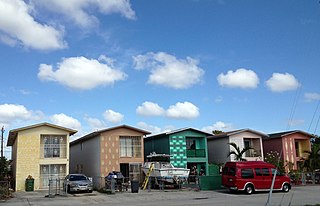
Hialeah is a city in Miami-Dade County, Florida, United States. With a population of 223,109 as of the 2020 census, Hialeah is the sixth-largest city in Florida. It is the second largest city by population in the Miami metropolitan area of South Florida, which was home to an estimated 6,198,782 people at the 2018 census. It is located west-northwest of Miami, and is one of a few places in the county—others being Homestead, Miami Beach, Surfside, Bal Harbour, Sunny Isles Beach, and Golden Beach—to have its own street grid numbered separately from the rest of the county.

Islandia is an unincorporated community and former city in Miami-Dade County, Florida, United States. It is located in the upper Florida Keys on the islands of Elliott Key and other nearby keys, such as Totten Key. It was the only municipality in the Florida Keys not located in neighboring Monroe County. The population was 18 at the 2010 Census. Most residents of the city were National Park Service employees.

North Miami is a suburban city located in northeast Miami-Dade County, Florida, United States, about 10 miles (16 km) north of Miami. The city lies on Biscayne Bay and hosts the Biscayne Bay Campus of Florida International University.. Originally the town of "Arch Creek", the area was incorporated as the "Town of Miami Shores", which was renamed the "Town of North Miami" in 1931. It was reincorporated as a city in 1953. The city is part of the Miami metropolitan area of South Florida.

Ojus is a census-designated place and formerly incorporated town in Miami-Dade County, Florida, United States. It is part of the Miami metropolitan area of South Florida. The population was 19,673 at the 2020 census, up from 18,036 in 2010.

South Miami is a city in Miami-Dade County, Florida, United States. The city is part of the Miami metropolitan area of South Florida. The population was 12,026 as of the 2020 census.

Miami Gardens is a city in north-central Miami-Dade County, Florida, United States. It is located 16 miles (26 km) north of Downtown Miami with city boundaries that stretch from I-95 and Northeast 2nd Avenue to its east to Northwest 47th and Northwest 57th Avenues to its west, and from the Broward County line to its north to 151st Street to its south. The city's name originated from Florida State Road 860, a major roadway through the area also known as Miami Gardens Drive. Miami Gardens had a population of 111,640 as of 2020. It is Florida's most populous city with a majority African American population and also home to the largest percentage of African Americans of any city in Florida, according to the U.S. Census Bureau. It is a principal city in the Miami metropolitan area of South Florida, which is the nation's ninth-largest, and world's 65th-largest metropolitan area with a population of 6.158 million people as of 2020. Miami Gardens is the home of Hard Rock Stadium, a 64,767 capacity multi-purpose stadium that serves as the home field for both the Miami Dolphins of the National Football League and the Miami Hurricanes, the University of Miami's NCAA Division I college football team, which has won five national championships since 1983.
Dana Albert "D. A." Dorsey was a businessman, banker, and philanthropist who became one of the first African–American millionaires in Florida and the American South.

Liberty City is a neighborhood in Miami, Florida, United States. The area is roughly bound by NW 79th Street to the north, NW 27th Avenue to the west, the Airport Expressway to the South, and Interstate 95 to the east. The neighborhood is home to one of the largest concentrations of African Americans in South Florida, as of the 2000 census. Although it was often known as "Model City" both historically and by the City of Miami government, residents more commonly call it Liberty City.
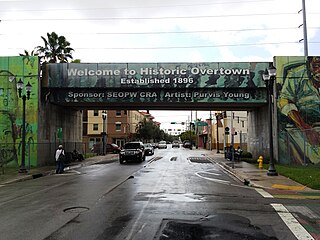
Overtown is a neighborhood of Miami, Florida, United States, just northwest of Downtown Miami. Originally called Colored Town in the Jim Crow era of the late 19th through the mid-20th century, the area was once the preeminent and is the historic center for commerce in the black community in Miami and South Florida.
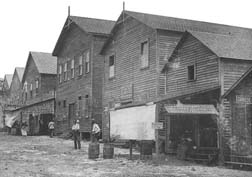
Thousands of years before Europeans arrived, a large portion of south east Florida, including the area where Miami, Florida exists today, was inhabited by Tequestas. The Tequesta Native American tribe, at the time of first European contact, occupied an area along the southeastern Atlantic coast of Florida. They had infrequent contact with Europeans and had largely migrated by the middle of the 18th century. Miami is named after the Mayaimi, a Native American tribe that lived around Lake Okeechobee until the 17th or 18th century.
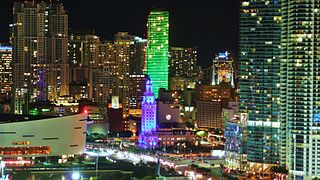
Downtown Miami is the urban city center of Miami, Florida, United States. The city's greater downtown region consists of the Central Business District, Brickell, the Historic District, Government Center, the Arts & Entertainment District, and Park West. It is divided by the Miami River and is bordered by Midtown Miami's Edgewater, and Wynwood sections to its north, Biscayne Bay to its east, the Health District and Overtown to its west, and Coconut Grove to its south.
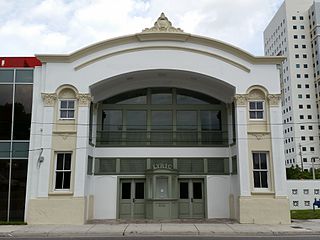
The Lyric Theater is a historic theater in Miami, Florida at 819 Northwest Second Avenue. It served Miami's African American community. On January 4, 1989, it was added to the U.S. National Register of Historic Places.

Roy Donahue "Don" Peebles is an American millionaire, real estate entrepreneur, author, national media commentator and political leader. Peebles is the founder, Chairman/CEO of The Peebles Corporation (TPC), a privately held real estate investment and development company he established in 1983.

The Miami-Dade Public Library System (MDPLS) is a system of libraries in Miami-Dade County, Florida.

Miami-Dade County is a county located in the southeastern part of the U.S. state of Florida. The county had a population of 2,701,767 as of the 2020 census, making it the most populous county in Florida and the seventh-most populous county in the United States. It is Florida's third largest county in terms of land area with 1,946 square miles (5,040 km2). The county seat is Miami, the core of the nation's ninth-largest and world's 65th-largest metropolitan area with a 2020 population of 6.138 million people, exceeding the population of 31 of the nation's 50 states as of 2022.

Carrfour Supportive Housing is a nonprofit organization established in 1993 by the Homeless Committee of the Greater Miami Chamber of Commerce. It develops, operates and manages affordable and supportive housing communities for low-income individuals and families in Miami-Dade County, Florida. Carrfour is Florida's largest not-for-profit supportive housing provider, housing more than 10,000 formerly homeless men, women and children in 20 communities throughout Miami-Dade County, assembling over $300 million of financing, tax credits and subsidies, and developing more than 1,700 affordable housing units since its founding.
The following is a timeline of the history of the city of Miami in Miami-Dade County, Florida, United States.

Miami Freedom Park is a 25,000-seat soccer-specific stadium currently under construction in Miami, Florida, United States. It is planned to be the home of the Major League Soccer team Inter Miami CF. In spring of 2022, final approval was given by the city of Miami to build a stadium on the current site of the Melreese golf course, close to the Miami International Airport. The decision followed a long process in which numerous locations were considered for the stadium. The current plans would see the stadium opened for the 2025 MLS season.



















